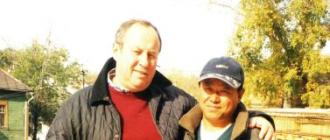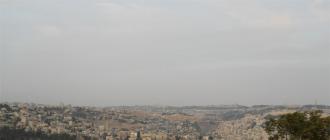The city of Kaspi is a small settlement that became a city only in 1959. However, it is a rather ancient place on the territory of Georgia. Historical sources mention Kaspi as early as 327. The modern city does not have particularly noteworthy places, although it has its own railway station, as well as a cement plant. Look at the sights.
There are many ancient historical monuments in the city surroundings. And the most famous are Ertatsminda and Kvatakhevsky monastery. Kaspi became the administrative center of the Kaspi municipality, which is located in the center of Georgia. In the southern part of the region there are deserted wild gorges, the Kura River flows through the center of the region, and there is also a valley here. Very beautiful.
Story
The first settlements on the territory of the Caspian Sea appeared here in the Bronze Age. Archaeologists suggest that Kaspi was a small city in the 6th-5th centuries. King Mirian visited the horn of Thoti in 327. According to legend, at this time the surrounding area was surrounded by darkness, then the king turned to the god of Nina with prayers, and the darkness receded. This is an epoch-making event for Georgia, because the king was baptized in the river, turning Christianity into the state religion. Rate it.
The first churches began to appear in the fourth century, by the way, they still exist, for example, the Church of the Ascension, Holy Mother of God and Teodora Tironi. In the city surroundings, churches such as the Church of Angels and the Matskhovari Church appeared. In the north-west of the city, the monastery of Thaddeus of Stepandzminda was founded in the 6th century; it also has the name Tetrakhevi.
Modern Kaspi
The city of Kaspi conventionally consists of three parts. In the city center there is a square connecting Stalin, Chavchavadze and David Agmashenebeli streets. In this central part of the city there is a railway station, the city hall, a local history museum and a square named after Saakadze. On David Agmashenebeli Street there is the Vakhtang Gorgasali Church and the bus station. In the south there are mainly industrial areas.
The Museum of Local Lore presents an archaeological collection that was collected during excavations in Metekhi, Rene and Kaspi. Therefore, you can see artifacts from the Bronze and Iron Ages here. The Theodore Tironi Church is located on Kostava Street, this building is the oldest building in Kaspi.
Kaspi (Georgian: კასპი)- a small regional center of Shida Kartli 48 km from Tbilisi. The city is located on the left bank of the Kura at the confluence of the Lekhura River. Railway station on the Tbilisi - Samtredia line.
The minibus departs from the Didube metro station. Cost 2 lari.
Population is about 15,000 people.
I think it’s worth warning from the very beginning that Kaspi is not the city that crowds of tourists flock to. There are no attractions of the level of Svetitskhoveli in Mtskheta, etc. Kaspi is a city with an interesting past, but this past must be seen. There are several historical monuments and a local history museum (essentially archaeological).
But there are quite a lot of “historical brands” in the Kaspi region.
In 327, King Mirian stayed in the surrounding area, on Mount Thoti. Then, according to legend, “darkness descended.” After which the king prayed to the “God of Nina” (meaning Saint Nino), and the darkness passed away. This moment became epoch-making for Georgia. After this incident, the king was baptized and established Christianity as the state religion.
So, in Kaspi some time later, in the period from the 4th to the 7th centuries. the first churches appeared that still exist today (Theodore Tironi, the Blessed Virgin Mary, the Ascension). Churches appeared in the surrounding area: Matskhovari (now located within the boundaries of modern Kaspi), the Church of Angels southwest of the city. North-west Thaddeus of Stepandzminda in the 6th century. founds a monastery known as Tetrakhevi.
Until the 8th century, Kaspi developed. It was a rich city because it was on a trade route. Most likely, it was surrounded by a fortress wall, so necessary in those days. And in 730, the Arabs marched here under the leadership of Mervan Kru (Deaf). Many cities ceased to exist, including Kaspi. After this event, Kaspi remained a small village until the middle of the 20th century.
Since the railway passed near Kaspi, factories began to be built here. This is how a slate factory, a cement factory, and an electrical apparatus factory appeared. And in 1959, Kaspi received city status.
Kaspi today. Kaspi can be roughly divided into three parts. The center of Soviet Kaspi is the square where Chavchavadze, Stalin and David Agmashenebeli (Builder) streets connect. In the center there is a railway station, a local history museum, the mayor's office, and a park named after. Saakadze. The bus station and Vakhtang Gorgasali Church are located on the street. David Agmashenebeli, near the center. The southern part of the city is mainly industrial areas.
Museum of Local Lore. Opening hours: 09.30 - 17.30. Closed: Sunday, Monday. .
The archaeological collection is based on materials from excavations carried out in Kaspi, Rene, Metekhi. Artifacts dating back to the Middle and Late Bronze Age, Early Iron Age (3rd - 1st millennium BC) are exhibited here; there are also exhibits related to antiquity and the Middle Ages. There are materials associated with the Trialeti culture (mainly the first half of the 2nd millennium BC) - ceramics found in mounds, clothing samples (XIV-XII centuries BC), harnesses, axes, tips ( XIII-VII centuries BC). Antiquity: silver disk found in the village of Sasireti (III century BC), bronze figurine of Dionysus (god of wine) (III-II BC), oichonia (ceramic vessels) (1st century AD .). The Middle Ages is represented by various ceramic dishes.

St. David Agmashenebeli comes from the north, along the Lekhura River, and divides the city into two parts: uninteresting eastern part- and Western, including " old town", where most of the historical monuments are concentrated. In the eastern part of the city there is only one inconspicuous Matskhovari church (V or VI century). Thoroughly renovated.
St. Kostava starts from Saakadze Square. Along it you get to the old city. Here is the Church of Theodore Tironi (Georgian: თეოდორე ტირონის ეკლესია). Above walk 250 m from the police building. This church is one of the most ancient buildings in Kaspi. But the painting is modern. Near the temple there are remains of a fortress wall. It is not entirely clear whether it only enclosed the church or was part of the city wall. It seemed that the wall had been renewed, perhaps more than once.
Church of Theodore Tironi

St. May 26. In the area of the police building, st. Kostava intersects with the street. May 26. If you walk along this street for about 500 meters and turn left into an alley, you will find yourself in a rather nice new church of St. George. It is located on the outskirts of the "old town" and has some good views.

St. Tsereteli. From the Tironi Temple, after walking another 200 meters, you can turn onto an inconspicuous street. Tsereteli. On this street the following follow each other:
Church of the Ascension (Georgian ამაღლება - amagleba).
Church of the Blessed Virgin Mary (Georgian: ღვთისმშობლის საყდარი - gvtismshoblis sakdari).
Kviratskhoveli (Georgian: კვირაცხოვლის ეკლესია - kviratskhovlis eklesia). The ruins of this church are located in the center of the old city. To find the church, you need to go around the building on the left kindergarten(it is directly opposite the entrance to the Church of the Virgin Mary).
All these temples were built between the 5th and 7th centuries.
On googlemaps the names of the churches do not match the names given above. This article provides names according to local residents.
Neighborhoods of Kaspi. If we talk about the accessibility of attractions in terms of hiking in the vicinity of Kaspi, the following historical monuments should be mentioned:
Caspian "burial grounds" (Caspian necropolis). A curious place just 500 meters from the western outskirts of the city. What is designated as burial grounds is a complex of rooms carved into soft rock, dating back to the 6th century. On the map (half a kilometer from the outskirts of the city) only one of the most interesting rocks with such premises is marked. It should be noted that along the way you can see several such caves.
Getting there is quite easy. 26 May Street ends at the street. Tsereteli. If you go to the right, you come out to the churches of Kviratskhoveli, the Blessed Virgin Mary and the Ascension. If you turn left, Tsereteli Street leads to the outskirts and smoothly turns into a dirt road leading to a complex of caves. The rock with multi-level rooms can be clearly seen from above (the dirt road at the very beginning goes down sharply). It should be noted that another inconspicuous cave is located almost at the very beginning of the dirt road. As soon as the descent begins, on the left you can see a rock where one room has been carved out.
| Coordinates: | |
|
|
|
Interesting moment. The Kaspi caves are located almost on the same line with the cave city of Uplistsikhe on the left bank of the Kura. Between Kaspi and Uplistsikhe there are several more such cave complexes. For example, near the Grakali railway station. From the village of Saireti, along the highway leading to Gori (and at the same time to Uplistsikhe), you need to drive 3.7 km. Thus, we get to the railway bridge. After crossing the bridge, you need to walk another 1 km east along a dirt road.
Architecturally, these caves are not as interesting as their Caspian counterparts. But out of curiosity (if you have a car and the desire) it’s worth a look.
Tetrakhevi Monastery. It is worth spending a few hours walking to the Tetrakhevi Monastery. To get to the monastery, you need to cross the bridge on the Metekhi highway (4.5 km from the city center). The road to Metekhi turns left, but we need to turn right, along the dirt road. The distance from the bridge to the monastery is 4 km. If you travel by car, you need to take into account that at the moment Only 2 km of the road (from the bridge) is passable. The primer is very washed out in one place. The remaining 2 km must be walked.
This monastery is associated with one of the Assyrian fathers - Thaddeus of Stepantsminda. First, he founded a monastery at the foot of Mount Zedazeni, and later moved to Urbnisi, where he founded the Church of the First Martyr Stephen. And finally, Thaddeus founded a monastery, now known as Tetrakhevi, where he was buried.
The church is a ruin. Inside, in the southern porch, human bones are collected in a box (!). Perhaps these are the remains of Thaddeus of Stepandzminda. To the east of the church there are traces of a water pipe. A well is found to the south.
The name Tetrakhevi itself translates as “White Gorge”. The abundance of limestone makes this area truly white.
| Coordinates: | |
|
|
|
Travel logistics. Approximate time a walk around Kaspi with inspection of the “burial grounds” (fortunately nearby) - 3-4 hours. It seems to me that the following route along Kaspi is more optimal:
Take a minibus to the bus station. Museum of Local Lore - Square named after. Saakadze - ascent along the street. Kostava, inspection of the Teodore Tironi Church - then until you turn onto the street. Tsereteli (primer). On the street Tsereteli we visit the Ascension, the Blessed Virgin Mary and Kviratskhoveli, then we go out to the intersection with the street. May 26. On this street, if you wish, you can look into the Church of St. George, or walk further along Tsereteli to the end. And there we already leave the city, and go down to the “burial grounds”.
From the "burial grounds" you can continue the route to the Tetrakhevi Monastery. But it’s worth considering that this will take at least another 3 hours, no less.
A complete list of historical monuments of the area is given in the description of the » Caspian Municipality
How to get to Kaspi. From Tbilisi (Didube metro station) to Kaspi a minibus costs 2 GEL (2013).
From Kaspi, if you missed the last minibus, you can get there by Borjomi train (train number 617), which arrives at 20:00. Ticket price is 1 GEL. The stop time in Kaspi is 1-2 minutes, the drive to Tblisi is 1 hour 10 minutes.
Information current as of June 16, 2014.
At the Kaspi bus station, minibuses Metekhi→Zemo Chocheti→Akhalkalaki→Akhaltsikhe and minibuses to Gori (Metekhi→Zemo Chocheti→...→Gori) were seen.
Below is the mileage:
Tbilisi (Metro station Didube) → Kaspi bus station (along the highway, via Igoeti) - 55 km.
Mtskheta (from the bridge) → Kaspi bus station (along the southern road, through Dzegvi) - 35 km.
Kaspi → Metekhi - 10 km.
Zemo Chocheti → Ertatsminda - 5 km.
Ertatsminda → Rkon Monastery - 12-13 km (dirt road)
Zemo Chocheti → Uplistsikhe - 25 km.
Kaspi → Samtavisi - 10 km
From the turn off the highway to Samtavisi - 2.1 km
Samtavisi → Kvemo Chala - 2.2 km
Kvemo Chala → Pantiani → Skhvilo Castle - 4.5 km (dirt road)
Kaspi, Shida Kartli, Georgia
The cozy city of Kaspi, nestled on the southern slopes North Caucasus, has a rich and eventful past. Although it received city status only in 1959, its history began in the 5th century, when an early medieval settlement existed on the site of the modern settlement. Kaspi is considered one of the oldest cities in the historical and geographical region of Kartli and is popular among travelers who, upon arrival in Georgia, rush to stroll along its streets and examine the preserved architectural monuments.
History of Kaspi

The first people lived on the site of modern Kaspi back in the Bronze Age. According to archaeological information, in the 6th–5th centuries BC there was an urban-type settlement on its territory, and possibly more large city. In chronicle sources, Kaspi is mentioned in connection with the legend of King Mirian, who, while on Mount Thoti, suddenly found himself in pitch darkness. After he prayed to Saint Nino, the darkness dissipated, and his prayer became epoch-making for Georgia. After such an event, the ruler was baptized and made Christianity the main religion of the state.
In the 5th century AD, Kaspi was already a full-fledged city, which had military-strategic and cultural significance, its own resorts and was considered an important center of the military-administrative part of the Caspian basin. In the 30s of the 8th century it was destroyed by Arab conquerors under the leadership of Merwan, after which for many centuries it remained only a remote village.
A new round in the history of Kaspi began in the first half of the 20th century. In the 1930s, a cement plant (the largest in Transcaucasia) was built on its territory, which served as an impetus for the development and expansion of the settlement. At the same time it became the administrative center of the Kaspi municipality, and in 1959 it received city status.
Modern city of Kaspi

Today Kaspi is an industrial town with a population of more than 15,000 people and is conventionally divided into three parts:
- The old city, located on a hill, at the confluence of the Lekhura River with the Kura. This is where the most interesting sights of the village are located.
- Eastern outskirts with one-story residential buildings.
- Southern industrial suburbs with factories and related infrastructure.

The city of Kaspi is built mainly on hills. To the south of it lie deserted gorges, and to the southwest lies the Kura River valley with vast lowlands and steppes. The climate in Kaspi is temperate, with cool winters and dry, hot summers. The air temperature in January is -1°C, in August it rises to +23°C. Average precipitation is up to 450 mm per year.
How to get to Kaspi

It is not difficult to get to Kaspi from many cities in Georgia. Tourists heading to the locality from Tbilisi can use several types of transport:
- with your own or rented car - along the Zahesi-Mtskhata-Kavtiskhevi-Gori highway;
- by minibus - departs from the Didube metro station;
- by train to Borjomi – departs from the capital’s Central Station and arrives in Kaspi after 1 hour 10 minutes.
In addition to Tbilisi, minibuses or buses from Mtskheta, Metekhi, Gori, Chocheti, Zemo, Akhaltsikhe, Akhalkalaki carry to the town.
What to see in Kaspi
Although the city of Kaspi cannot boast of an abundance of architectural monuments, there are a number of interesting sights on its territory that deserve the close attention of tourists.
- Church of Theodore Tironi






The ancient church, located on Kostava Street, is considered the oldest building in the city. Built in the 5th century, it has since been extensively renovated but retains its authentic medieval charm. Of particular interest inside the temple are the bright frescoes, which, although modern, are radically different from the traditional remodels in other Georgian churches.
- Temples of the 5th–7th centuries
Walking along the streets of the village, in different places it is easy to notice ancient churches, basilicas and ruins of temples built during the era of prosperity of Kaspi in the 5th–7th centuries. These include the churches of the Blessed Virgin Mary, Ascension, Kviratskhoveli, Matskhovari, and St. George.
- Museum of Local Lore
On the central square of the city stands a two-story building in which the local history museum operates. The greatest value is its archaeological collection, which includes artifacts from the Bronze and Early Iron Ages (from the 3rd to the 1st millennium BC), as well as objects from antiquity and the Middle Ages. A significant part of the exhibits are finds discovered during excavations in the territory of Kaspi, Metekhi and Rene.
- Caspian necropolis

0.5 km from the western outskirts of the town there is a complex of “burial grounds” dating back to the 6th century AD. It consists of small caves cut out of soft rock for the burial of inhabitants. What’s interesting is that the Kaspi caves rise on the same level as the Uplistsikhe Odnoklassniki caves
Kaspi (კასპი) is a small regional center in Shida Kartli with a population of about 15,000 people. This is a city with a large, interesting past and a very gray present. Once there was a large and important early medieval settlement, but now it is an industrial regional center with a cement plant and Khrushchev architecture. And yet, some traces of past greatness remain.
Story
Kaspi is located in the valley of the Kura River. This is a flat plain with a height of about 530 meters, through which the Lekhura River flows from the north. On the right bank of the river, a hill is wedged into the valley in a triangle, which is about 40 meters higher than the surrounding plain. People of antiquity loved such heights near rivers, so in eras unknown to us a settlement arose here. The left bank of the Kura was popular in the era around 1500 BC, so chances are high that the settlement arose then. Archaeologists (A. Apakidze) speak about this point as follows:
To illustrate this point, we point to Khovle, Kaspi and Mtskheta. All these settlements are located on the territory of Iberia, in the valley of the river. Kuri, between Tbilisi and Gori, is less than a hundred kilometers away and is therefore located on the trade and transit route; they arose approximately simultaneously. Excavations have established the undoubted fact that on the site of these points, starting from the Eneolithic era, with some interruptions, settlements existed. Since the Early Bronze Age, these settlements have developed quite systematically. From the first centuries of the 1st millennium BC. e. Khovle, Kaspi, Mtskheta and some other points emerge as large and developed settlements, where it is easy to see the beginnings of future urban life. ... Further development These settlements, as it turns out, took different paths. Mtskheta became a city in the VI-V centuries. BC e. Kaspi became an urban-type settlement, and perhaps a city...
In 327, King Mirian went hunting in the Mukhrani forests, and from there climbed Mount Thoti, precisely to look at the city of Kaspi from above. Everything begins with this event long history baptism of Georgia. Immediately after the Christianization of Georgia, the first temples appeared in Kaspi. The Tironi monastery in the center of Kaspi is considered such, although exact time its construction is unknown. Presumably in the 5th century, the temples of Kviratskhoveli (or V or VII) and the Virgin Mary (V or VI) appeared. In the 6th century, the temples of Subnishani, Matskhovari and to the west of the city - the Temple of the Archangels appeared. To the northwest on Mount Tslevi, Thaddeus of Stepantsminda (one of the Assyrian fathers) builds a temple, now known as the Tetrakhevi Monastery. He will be buried there.
In those years it was a real trading city, perhaps even with walls and towers, and everything lasted so rosy until the beginning of the 8th century. In 730, the Arab invasion of Mervan occurred, and all the cities on the left bank of the Kura were destroyed. Kaspi has turned into a modest village.
IN Soviet era he was lucky to be on the line railway, and industry began to be created here. A cement factory, a slate factory, an electrical apparatus factory, a cannery and all the associated infrastructure arose. In 1959, Kaspi received city status.
Kaspi today
Nowadays, Kaspi consists of three sectors: the “Old Town”, the rural eastern outskirts and the southern industrial suburbs. From the west you enter the city along Stalin Street, from the east - along Chavchavadze Street. They meet at the bridge over Lekhura - this is the heart of the Soviet sector. There is a railway station, a couple of bazaars, a newly built temple of Vakhtang Gorgasal, a local history museum, a bus station (on the banks of Lekhura), the mayor's office and a square with a monument to Saakadze. To the south across the river there are already factory districts.
From the bridge over Lekhura to the north, along the river bank, the street of David the Builder leads; it stretches for about 3 kilometers to the northern edge of the city, there it turns into a road and after 5 kilometers it comes to Igoeti, where it connects with the Batumi highway. Total distance from the highway to the center of Kaspi is 8 kilometers.

Lekhura River within the city of Kaspi
David the Builder Street divides the non-Soviet Kaspi into two halves. The eastern one is an uninteresting outlying development, and the western one is the same old part of the city on a hill. It is more rational to go there from the station square along Kostava Street. You will need to walk 500 meters past the municipality and the First School building, then a gentle climb will begin. Above there will be the city police building, behind which there is a fork, and Kostava Street turns to the right. After 200 meters around the bend on the right there will be Tironi Monastery. It seems to be considered the oldest building in the city, although it has now been greatly updated.
Monastery of Tevdore Tironi Coordinates: |
|||
 |  |  |  |
This temple was built very roughly in the 5th century, and now it is clear that its vault was restored and the southern wall, which was slightly tilted, was strengthened. On the northern side, a fragment of the fortress wall was destroyed. In this temple it is worth paying attention to the frescoes. They are modern, but noticeably different from ordinary remakes.
To find the rest of the antiquities, you need to walk north along Kostava another 200 meters and turn left, for example, along Tsereteli Street. On the right on Tsereteli there is a very small temple in a dilapidated state. It is generally believed that this Temple of the Ascension, also built in the 5th or 6th centuries.
On the left around the corner - Shubnishani Temple 7th century (sometimes called Kviratskhoveli). This is practically the very center of the old city.
Strictly in a straight line from Shiosubani to the west is the domed Church of St. George. You will have to go there in zigzags, and the temple itself looks new, but it stands on the very edge of the hill of the old city and offers good views of the Kura Valley.
Well, on the northernmost outskirts of the city you can find the Matskhovari (Savior) temple, which was founded almost in the 4th century, but was subsequently heavily rebuilt.
Kaspi Local Lore Museum
Kaspi has its own local history museum on two floors - it is located near the central square, a little to the east of it. There is a good archaeological department there. Currently (summer 2015) closed for renovation.
Hit
The easiest way to get to Kaspi is by minibus, although you can also try by train. Hitchhiking is also possible if you first take the highway to Igoeti.
Kilometers: 30 kilometers from Gori on the southern road and 36 kilometers if on the highway. From Mtskheta - 33 kilometers south by road. From the center of Tbilisi 54 kilometers, from the northern outskirts (ZAGES) - 36 kilometers.
Around Kaspi
From the city center you can climb Mount Thoti- it will be 6 kilometers of roadless slope. In the west, 9 kilometers away - the village of Metekhi and Metekhi Temple XIII century. There are still some mysterious "k Asp burial grounds"in view of the grottoes carved into the rock. This is about 500 meters from the western edge of the city. You can get there, walk to the Old Cemetery, go beyond it into the fields and then turn down the slope. It is not marked in any way. The "burial grounds" are rooms , carved into a sandstone rock. It is clear that much has already collapsed over time, and only in one rock these rooms are visible relatively well. What it was is difficult to say.
Kaspi is a small and cozy town in Georgia. Its population is only 15 thousand inhabitants.
Kaspi is an authentic and hospitable place for tourists. Small Georgian houses seem to have stepped out of the pages of an ancient oriental fairy tale, and the locals honor the tourist no less than their ruler.
Natural beauty
The oldest part of this town is located on a hill, so it offers stunning beauty. Here you can also find the most famous sights of Kaspi. The entire city is on hills.
How to get to Kaspi
You can get to Kaspi either by private car or by minibus. The easiest way to get to Kaspi is along the Zahesi-Mtskheta-Kavtiskhevi-Gori highway. If the tourist prefers minibuses, then they go to the city directly from the Didube metro station.
An alternative option is the train. It departs from Tbilisi Central Station. After 50-60 minutes the tourist will already be in Kaspi.
What to see in Kaspi
In this town you can find many architectural monuments. Each of them is unique and inimitable, therefore worthy of special attention. It is best for foreign tourists to visit the famous Museum of Local Lore. In it you can see a rare archaeological collection that will not leave indifferent anyone who appreciates the art and culture of antiquity.
The Caspian necropolis is a real find for tourists. The huge complex of burial grounds looks like a majestic and mysterious reminder of human life centuries ago. No less interesting are the caves that are located here. They're like scenery from movies about Ancient Egypt. The caves alone are enough to come to Kaspi. Centuries-old temples and monasteries will also find their admirers, so you definitely won’t get bored in this hospitable Georgian town.
Narrow streets and fragrant national cuisine, local color and hospitable residents, incredibly beautiful mountains and ancient architectural monuments... The advantages of Kaspi can be listed for a very long time, but one thing is for sure: this city will leave an unforgettable impression in the memory of every tourist.






